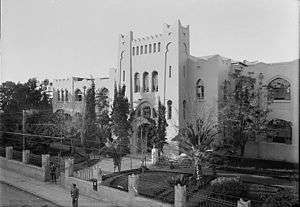Battalion for the Defence of the Language
The Battalion for the Defence of the Language (Hebrew:גדוד מגיני השפה, pronounced: Gdud Meginei Hasafa) was a small but militant body established by Jewish students at the Herzliya Hebrew Gymnasium in Tel Aviv, Israel in the 1920s to urge Jews to use only the Hebrew language.[1]

The group campaigned against the use of other languages under the slogan "Jew, speak Hebrew." Its most prominent supporters were Mordechai Ben-Hillel Hacohen, a Hebrew writer, Zionist and one of the founders of Tel Aviv, and Zvi Yehuda Kook, the son of the chief rabbi Abraham Isaac Kook.[2]
The Jewish (mostly Yiddish) press tended to portray the group as "a gang of fanatic, insolent hoodlums" and although the battalion was sometimes involved in violence it acted largely "as patriotic watchdog, barking loudly and baring its teeth but seldom actually biting."[3]
On 15 August 1929, the Jewish fast of Tisha B'Av, 300 youths led by Jeremiah Halpern, who were mostly from the Battalion with some from Betar and other youth movements, made political speeches, raised the Zionist flag and sang the Zionist anthem at the Wall. A counter-demonstration by Muslims on the following day was followed by violent incidents and subsequently led to the 1929 Palestine riots and especially the destruction of the Jewish community in Hebron.[4]
See also
- Pro-Wailing Wall Committee
- Western Wall
- 1929 Palestine riots
- Association for Palestinian Products
Notes
- Frank, 2005, p.37; Meyers, 2002; Segev, 2000, p. 264.
- Segev, 2000, p. 264; Segev, 2009.
- Segev, 2000, p. 264.
- Segev, 2000, p. 310.
References
- Frank, Mitch (2005). Understanding the Holy Land: Answering Questions About the Israeli-Palestinian Conflict. Viking. ISBN 978-0-670-06032-0
- Meyers, Nechemia (2002). Yiddish Lives - A Language That Refuses to Die. The World and I, February 1.
- Segev, Tom (2000). One Palestine Complete: Jews and Arabs Under the British Mandate. Abacus. ISBN 978-0-349-11286-2
- Segev, Tom (2009). When Tel Aviv was a wilderness. Haaretz, 10 May.